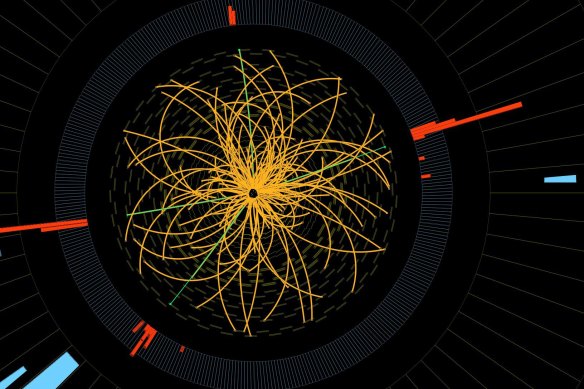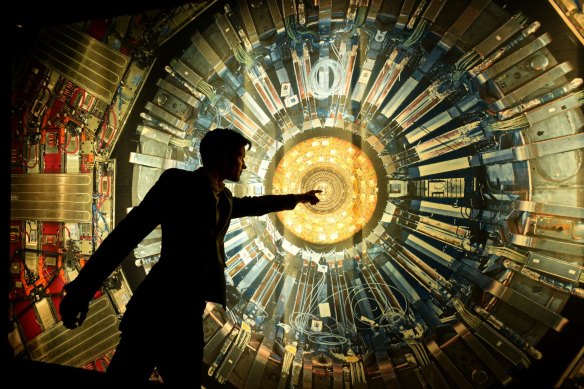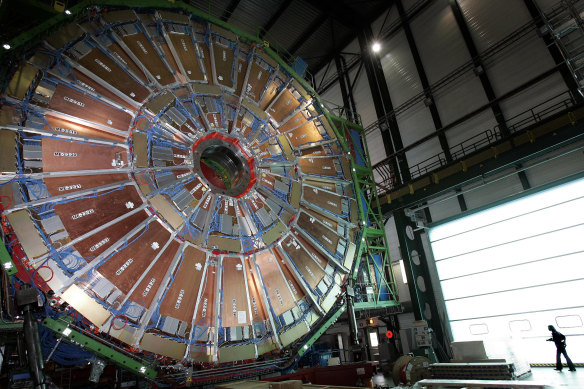Explainer
- Explainer
- Science
Ten years on from the God particle, we may have found a fifth force of nature
It took four decades to find. Homer Simpson predicted it. And, depending on who you ask, it could one day destroy the universe. What’s the Higgs boson? And what is left to discover?
Beneath the Alps, there’s an elevator that leads deep underground. It used to be a joke that it led down to Hell. There is an inferno at the end, after all, but it’s a fireball on a different scale. Imagine the energy of a train at high speed squeezed through a beam narrower than a hair’s breadth. This is the Large Hadron Collider (LHC) – the world’s biggest machine, spanning a 27-kilometre racetrack. It smashes together subatomic particles at close to the speed of light and then hunts for the secrets of our universe in the debris.
When it was first turned on in 2010, some feared it really would open the gates of Hell, or at the very least unleash a planet-guzzling black hole. Fortunately, the LHC didn’t destroy the world (far more energetic space particles already hit our atmosphere every day). But within the machine’s fiery collisions, the Higgs boson – that elusive “God particle” that gives things mass – was at last found in 2012.
Now an even bigger discovery could be on the horizon. The collider has just been switched back on, more powerful than ever after a three-year upgrade, and scientists expect this run will confirm whether recent anomalies in their data are a fluke or a sign of something else: a fifth force of the universe, no less. Dr Mitesh Patel, a lead physicist on one of the LHC experiments for CERN, Europe’s particle physics lab, calls them the most exciting results he’s seen in his career, even as he urges caution. “My colleagues were ribbing me when I said I was shaking [seeing the data] but it’s true, I got that lurch in your stomach. If it holds up, this is huge.”
Hopes are also high that the collider will finally help solve one of the biggest mysteries of all: dark matter.
Upgrades on the LHC were completed, while the machine was offline due to its radiation. The collider simulates conditions similar to the Big Bang that created the universe and uses powerful detectors to analyse the debris. Credit: CERN
What’s the Higgs boson, again?
Half a century ago, Peter Higgs and a handful of other physicists around the world were puzzling over one of those particularly thorny questions: why do some things have mass and others don’t? Mass is not just the heft of something; it’s how much resistance an object puts up to being moved. It’s the “M” in Einstein’s famous E=MC² equation which tells us that energy and mass are actually the same thing – and that means when you smash particles together with enough force in a collider like the LHC, that energy will spin back into matter. Do it at high enough speeds over and over again, and you might even make particles rarely seen, like a Higgs boson.
Most of the mass of anything, including our bodies, comes from the binding energy holding the fundamental particles together inside our atoms, Patel explains. But the remaining sliver of mass is already intrinsic to those elementary particles. So, where does their mass come from? To solve this mystery, Higgs (and separately others) proposed the idea of an invisible field overlaying everything in the universe, later dubbed the “Higgs field”. It’s been described as a kind of cosmic tar, dragging on particles as they move through it, with some encountering more resistance (and so having more mass) than others.
The Higgs boson was originally known as the “goddamn particle”, given, in the words of one physicist, it was so “goddamn hard to find”.
You can imagine it as a snowfield. Skiers might glide through the snow fairly easily, as lighter particles such as electrons will, meaning they have very little mass. But someone plodding home to their cabin in big boots will struggle along “like trying to move through treacle”, Patel says, just as heavier particles such as W bosons do.

Scientists at the CERN lab in Geneva celebrate the resumption of collisions of the Large Hadron Collider on July 5, 2022Credit: CERN
Unlike other quantum fields, the Higgs field never fully relaxes – it is always taut with energy. (In fact, if it ever did relax, Stephen Hawking and other scientists have warned it would rewrite the rules of matter – and wipe out all of existence.)
When the field gets particularly excited, a ripple emerges we interpret as the Higgs boson, like the bump you get when you twitch a rope. One CERN scientist, suddenly facing down the world press at the announcement of the Higgs discovery in July 2012, described it like this: imagine the Higgs field as a waiting media pack. A celebrity (heavy particle) will be mobbed by the journalists, where someone unknown (i.e. lighter) would slip easily through. Likewise, a juicy rumour (the Higgs boson) will travel through that media scrum, drawing journalists together from one end to another in a bump.
The Higgs was the missing piece in the “standard model” that has explained particle physics for the past half-century. Finding it proved the Higgs theory right (and its mass came eerily close to a prediction in a 1998 episode of The Simpsons). But the hunt took more than four decades. Before the nickname “God particle” took off, the Higgs boson was known as the “goddamn particle”, given, in the words of one physicist, it was so “goddamn hard to find”. In the end, CERN member countries in Europe had to build the LHC, at a cost of about $A6.5 billion, just to generate enough collisions at energies high enough to spew forth a particle as heavy as the Higgs.
The Americans almost found it first. But their plan to build an even bigger collider than the LHC under Texas was shelved in the early 90s after Congress cut off funding. Then-President George H.W Bush snr had reportedly been about to ask Japan to pitch in $1billion to keep the project alive when he famously vomited on the Japanese Prime Minister during a visit and, some physicists groan, set American physics back a decade.

2011 image of a real proton collisions picked up by the LHC detector showing the signature decay of a Higgs boson.Credit: CERN
So, why are we smashing particles together now?
The standard model is beautiful – it elegantly lays out the foundational particles and three of the forces of nature (electromagnetism and the strong and weak nuclear forces that hold atoms together), allowing physicists to accurately predict and explain the world around us.
The problem is this model has to leave things out to work. It can’t explain gravity, the fourth and (so far) final force of nature. And it can’t explain either dark matter, that mysterious scaffolding we know is holding the universe together, or dark energy, that equally unknown force pushing it apart. Together, dark matter and dark energy account for 95 per cent of the universe (ordinary matter like you and I and the galaxies around us make up the rest). That’s a lot of ground for discovery, says astrophysicist Professor Alan Duffy. “The atoms of everything we know are very much the afterthought of the universe,” he says. “Most of it is something else entirely. But it’s the reason we’re here.”
Scientists have been hunting for decades for something that will definitively break the standard model and usher in a new era of physics. So far, they haven’t found much. But let’s return to our scientific cliffhanger. Before the LHC was switched off for its refurbishment, Patel’s team had begun to see a strange signal in their data.
In the subatomic realm, particles interact and change all the time. And, according to the standard model, those known as beauty quarks should decay as often into muons as they do into electrons. But on the CERN team’s measurements, they became electrons 15 per cent more often than the muons, suggesting something could be tipping the scales.
“It’s a revolution for the science. We can do things we couldn’t dream of doing before, looking at much rarer [phenomena].”
Dr Mitesh Patel, Imperial College London and CERN
On the data so far, the team calculates there is a one in a thousand chance these “tantalising abnormalities” are a fluke – known as a three sigma event. “That’s generally what we call evidence, so time to look closer,” Patel says. “But five sigma is really when you say you’ve discovered something, like when they announced they’d found the Higgs. That’s about one in 3 million. That’s what it takes to convince the community.”
And, he notes, the Higgs was already predicted in the maths. “People were looking for it. What we’re seeing now, nobody expected. So even if we reach five sigma, they might rightly want more measurements by other [labs]. It could be a problem somewhere in the analysis, it could be a fluke.” When billions of particles are colliding around the clock, strange things will happen. “One doesn’t go around claiming new forces of nature just like that. But we’ll know [one way or the other] this run” of the collider.
There are other weird measurements too, some with even more data, that could signal the same phenomena. In the US, the Fermilab has found muon spins do not match predictions under the standard model, while the W boson has been revealed to be much heavier than expected.
And then there’s the Higgs boson itself: it’s much lighter than expected. “It doesn’t really make sense on its own,” Patel says. “Everything about it tells us its mass should be much heavier. So, is something keeping it low? That’s what makes us think there’s something else.”
The LHC upgrade will be a “revolution” for this research, he says. Not only will it deliver more power and more collisions, but beefed-up artificial intelligence too to help scientists “spot those needles in the haystack” within the resulting debris. “The data that used to take five years, we’re now going to get in one,” Patel says. “And we can do things we couldn’t dream of doing before, looking at much rarer [phenomena].”
He’s keen to explore if the strange effects on muons are also playing out among heavier particles known as tau leptons, which are harder to study but may yield even more dramatic results. “If you see something small in the muons, maybe you can see bigger effects from any new force of nature or any new particle on the taus.“

Professor Alan Duffy with a photo of the LHC’s main magnet during a talk at a CERN exhibition in Sydney. The real magnet is 15 metres tall.Credit: Steven Siewert
What about the hunt for dark matter?
Right now, scientists think a ghostly wind is flowing through you, something you cannot see or feel, something that doesn’t reflect light or appear to interact with your atoms. But they know something is there because they can see its effects; they can map its skeleton as its gravity bends light and pulls on stars. It’s known as dark matter – “matter” because we know it has gravity, and “dark” because, well, we don’t know anything else. “It’s the gravitational backbone of the universe,” Duffy says. It outweighs all other matter five times over.
“Dark matter is a ghost...but it’s the gravitational backbone of the universe. We know it’s there because nothing is possible without it.”
Professor Alan Duffy, Swinburne University
“The best evidence it’s there is that we are here,” says Duffy, who runs supercomputer simulations creating mini-universes to test theories at Swinburne University. “If you forget to put the dark matter in [to the simulations], you realise very quickly because nothing is formed by the present day, no galaxies or planets. It’s as clear as that.”
So how to find it? Since physicists don’t know what dark matter is, they can’t build a detector specifically for it. But it’s hoped that the particle-smashing power of colliders like the LHC may yet produce it. “It’s an accounting game,” explains Duffy. “Dark matter is a ghost. But, since you know what you put in, in terms of energy, if there’s something missing afterward, then you may have produced dark matter in that collision.”
You can also play the waiting game. Deep underground in an old Victorian gold mine, Duffy and an international team headed by Professor Elisabetta Barberio hope special crystal detectors will flash if dark matter collides with their subatomic parts. To rule out other interference, these crystals have to be sheltered deep under rock, away from the cosmic rays of faraway stars. “Billions of dark matter particles are passing through those detectors every second,” Duffy says. “So occasionally, we hope, one of them will collide with the nucleus of an atom and send it recoiling, like a snooker ball, causing a flash of light from the crystals.”
Others speculate whether dark matter is really the effects of matter in another universe – gravity leaking through a multiverse into our own. It sounds like a Marvel film but Patel says “there are decent foundations” for the theory, namely that scientists still don’t understand why gravity is so much weaker than the other three forces of nature. “So people have speculated that maybe gravity behaves differently because it’s spread out in other dimensions in addition to our own”.
Still, Duffy thinks that dark matter is itself a particle “something you can hold in your hand, something out there, waiting to be found”. We just have to catch it. There are already a number of candidates: theoretical particles with wildly different properties and increasingly more inventive names including “WIMPs” (weakly interacting massive particles) and their Godzilla-heavy alternative “WIMPzilla”. Contenders range from axions, expected to be a billion times lighter than any particles found so far, all the way up to black holes left over from the creation of the universe.
“Black holes are famously invisible, they have gravity, so there’s a dark matter candidate right there,” Duffy says.“But they’d also need to be very small of course, or we’d see monster effects.”
Hawking theorised that black holes born in the earliest moments of the universe may have shrunk down so much over the eons (evaporating in a process known as “Hawking radiation”) that they are now nearly impossible to see. “So we’re still talking billions of tonnes in mass inside, but they’re physically tiny,” Duffy says.
If they’re too small, of course, Hawking radiation will have already snuffed them out so his Phd student Renee Key is looking at the last possible “sweet spot” of black hole size to rule the theory in or out. Using a powerful telescope in Chile, she’s scanning the stars of our neighbouring galaxy for signs of these “baby black holes” passing in front of them – “then the star might brighten for a moment as the gravity of the black hole acts as a magnifying glass, even a tiny one like Hawking proposed”.

CERN scientists observe the resumption of collisions of the Large Hadron Collider from the control room.Credit: CERN
Given the Higgs boson is supposed to interact with anything with mass, some scientists wonder if it too could open a kind of portal to dark matter. “If dark matter talks to the Higgs, gets its mass from the Higgs, then can the Higgs produce dark matter?” Patel says.
Certainly, the discovery of dark matter would rank alongside the God particle as one of the greatest so far – on the sheer quantity of it alone, Duffy says. He’s hopeful it’ll happen in his lifetime. “It took us a century to find the gravitational waves that Einstein predicted. We’ve only really been searching for dark matter for half that time, and humans are fantastically clever.”
If decaying black holes do explain dark matter, then the world will also have found a window “into potentially the earliest trillionth of a second of our universe’s beginning”, Duffy says. “It could answer fundamental questions about the world around us. Why are we here? Why is there something, rather than nothing? Why is dark energy accelerating the expansion of the universe?”
What does any of this have to do with me?
Particles smashing together on a scale too small for human eyes to catch somewhere beneath the French-Swiss border may not feel particularly plugged in to everyday life, but these questions cut right to our idea of reality. And they can advance technology in unexpected ways. A plaque outside Patel’s old office at CERN reminds passersby that the Geneva facility was also the birthplace of the worldwide web. (British scientist Tim Berners-Lee invented it in 1989 to help researchers share their work.) Particle physics research has produced the X-ray and PET scan, while the hunt for dark matter has helped refine air radar and plane landing sensors. “Some of my colleagues are now working on firing protons at cancer tumours to treat them in a way that’s healthier for the surrounding tissue,” says Patel.
“You do have to pinch yourself every time you see it working. The whole place is a cathedral to science.”
Dr Mitesh Patel
If we find the elusive dark energy, we may have even discovered a means to prop open Einstein’s theoretical wormholes – perhaps one day long enough for a ship to zip through the shortcut in space time, helping overcome the tyranny of distance looming for interstellar travel and delighting science fiction fans the world over.
To be at CERN’s collider is to feel the magic of possibility, Patel says. Some of the buildings are a little shabby now (“they were built in the 50s, my wife was not impressed”, he laughs), but others look like a film set, with layers of iris scanners and radiation checks between you and the big machine 100 metres underground. “The LHC control room above really does feel like those movies when you’re at mission control,” Patel says. “There are screens and projectors and lights.”
Eventually, if CERN can secure billions more dollars in funding, it hopes to build an even more powerful accelerator, 100 kilometres around, to allow it to produce new kinds of particles again. But, already those in the LHC beam whip around the track hair-raisingly close to the speed of light (which nothing with mass to slow it down can break). “In fact, if you had a race between the protons we’ve accelerated and light itself, right around the Earth, at the finish line our particles would only be 40 centimetres behind,” says Patel.
“So you do have to pinch yourself every time you see it working. It’s such an engineering marvel. The whole place is a cathedral to science.”

A woman walking beside the LHC’s largest magnet, which helps propel particles along close to the speed of light.Credit: AFP
Let us explain
If you'd like some expert background on an issue or a news event, drop us a line at explainers@smh.com.au or explainers@theage.com.au. Read more explainers here.